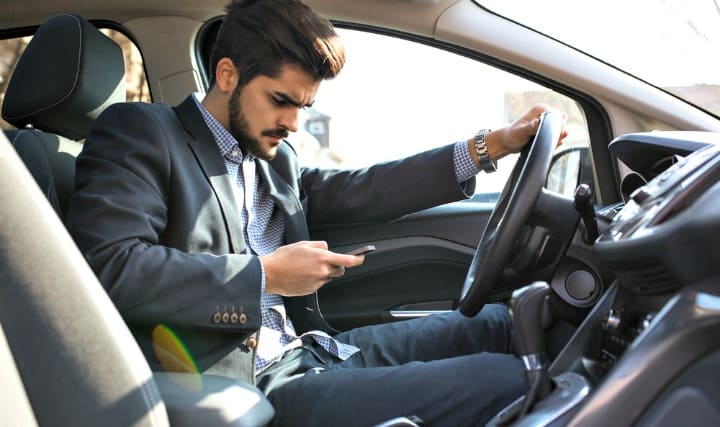What Texas Drivers Can Expect From the Statewide Texting Ban and Technology’s New Role

Texting and driving will soon be illegal in the state of Texas.
In early June, Gov. Greg Abbott signed into law a bill that creates a statewide ban on texting while driving. The news was met with cheers by lawmakers who had been pushing such a bill for many years.
Rep. Tom Craddick, the Midland Republican who authored the bill, said in a statement that “by enacting this public safety legislation, the governor is saving lives by deterring this dangerous and deadly behavior.”
The measure, which goes into effect Sept. 1, bans reading, writing and sending electronic messages from a handheld phone while the user is driving a moving vehicle. Violators will be issued a citation of $25 to $99 for a first offense. Fines will rise to $100 to $200 for additional offenses.
There are some limits to the measure, though. The law does not address speaking on a phone while driving. Under the new measure, drivers will still be able to use handheld phones to use GPS.
Statistics show that any move to ban texting while driving can be helpful in preventing crashes. The National Safety Council released a survey in February of 2017 in which 47 percent of drivers admitted to texting either manually or through voice controls while driving.
The National Highway Traffic Safety Administration said that distracted driving — which includes using cell phones while driving — resulted in 3,477 deaths and 391,000 injuries in 2015 alone.
Texting while driving can dramatically increase motorists’ chances of causing an accident. The National Safety Council reported in 2015 that cell phones were involved in an estimated 27 percent of all car crashes in the country.
Texas-sized debate over texting while driving
Texas had been one of four states that do not ban drivers from texting while driving. The three other states are Arizona, Montana and Missouri, which only bans drivers under the age of 21 from this.
This spring, Texans witnessed firsthand how deadly the consequences of texting and driving can be.
CHECK OUT: The Most Dangerous States to Drive
On March 29, a pickup truck collided with a church bus traveling on a highway near San Antonio. The accident killed 13 of the bus passengers.
Witnesses say that the driver of the pickup truck admitted that he had been texting while driving immediately before the accident. Witnesses told news media covering the accident that the truck could be seen swerving in and out of its lane and almost hitting other vehicles before it collided with the church bus.

The accident was still under investigation as of the time of the writing of this story.
Even before the accident, Texas lawmakers were making their latest attempt to pass the bill banning texting while driving in the state.
In late March, the Texas House of Representatives voted to approve House Bill 62, legislation that would ban texting while driving in Texas but would still allow the use of handheld phones for speaking and GPS systems.
Craddick said in a statement that the fatal bus accident was more proof of how important the bill was.
“No message or email is important enough to risk jury or death while driving on our Texas roadways,” Craddick said in his statement.
RELATED: How a Moving Violation Affects Your Insurance Rates
During the debate in the Senate, Sen. Joan Huffman from Houston acknowledged that a new law won’t prevent all drivers from texting while behind the wheel. But it might stop some, and that is enough of a positive to justify the new measure, she said.
“This bill is a common-sense approach toward increased public safety and I stand with my colleagues and constituents in support,” Huffman said in a statement after the San Antonio-area bus accident.
How to stop texting while driving
Technology, though, may catchup to lawmakers. Three things could change how texting and driving is handled, with one already available to parents wanting to keep their teen or other drivers safe.
Parental controls
 CellControl cuts down on phone use while driving with the help of two components – a hardware device that attaches to the window in the vehicle called DriverID and your phone app. Something families can use.
CellControl cuts down on phone use while driving with the help of two components – a hardware device that attaches to the window in the vehicle called DriverID and your phone app. Something families can use.
Parents can disable a phone in a car from texting, emailing surfing the web as well as texting and access to Facebook. It kicks in as soon as the car starts.
DriverID hardware costs about $130 with additional subscription fees for monitoring.
And if you have a smart teen, you are notified if the device has been tampered with.
There’s also a Life360 app made for Ford vehicles. It’s similar to DriverID by suspending incoming texts when the car is moving. Once the car stops, the messages will be sent.
Super high-tech
SeeingMachines, meanwhile, is taking driver technology to the next step with its face-tracking camera that can detect when a driver’s eyes look away from the road, such as sending or responding to texts. Once detected the device can sound an alarm to the driver or alert them in other ways, such as shaking the seat or brake pedal.
The device, which is still in development, can be mounted on the dashboard and will track things such as your eye movements — even the number of times you blink
“Driver fatigue and distraction are clearly major contributing factors in vehicle accidents,” says Mike Lenne, Seeing Machines general manager–human factors.
Law enforcement
You’ve heard of a breathalyzer, but probably not a textalyzer. That could change in Texas if it follows the lead of New York lawmakers who are currently pushing legislation that would allow authorities to check drivers’ phones for signs of distraction following an accident, and to impose penalties for refusing that could burden drivers down the road.
A bill that would legalize the use of “textazlyer” devices for determining activity on drivers’ phones is seeing bipartisan support from New York lawmakers, WGRZ Buffalo reported.
If passed, it could make New York the first state to implement the technology for catching distracted drivers.
Basically, the bill would require drivers who’ve been involved in an accident to let authorities scan their phones for evidence of recent use, or face penalties and license suspension, both at the time and later on, if they refuse, according to Forbes.
The New York legislation would be known as as Evan’s Law, named for 19-year-old Evan Lieberman, who was killed in a 2011 car crash that was later found to be the result of distracted driving. His father Ben Lieberman told NPR he’d “found out the hard way” after his son’s death that obtaining driver phone records after an accident in most states can be “an agonizing process.”
